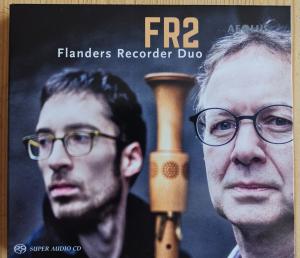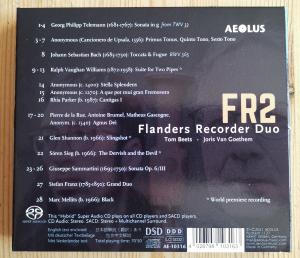FR2 - Flanders Recorder Duo


Tom Beets und Joris Van Goethem
The key to great teamwork is mutual understanding and friendship. Joris and Tom have toured the world for many years with the Flanders Recorder Quartet. In that capacity they have arranged, taught and played music together since 2008. They found each other in countless rehearsals and numerous conversations about music, recorder, viols and life. It became a collaboration without equal that led to dozens and dozens of concerts and workshops a due.
Where lie the origins of this CD? The idea grew organically. Probably the first stone was laid high in the sky in between two continents, maybe by Tom, or could just as well be by Joris. “Maybe some time we should…?” And so we started of playing through two libraries of duet repertoire, thinning the long list down to the best, the most interesting, the pieces that fit best for us and our instruments.
There is no plentiful of recordings with two equal instruments or recorders. Most common are the recorder quartet or quintet, and not to forget the solo player, with or without accompaniment. Not only they, but also the duet, has a rich tradition. Composing for two is an art of all times, from the prudent polyphony in Musica enchiriadis through the many bicinia and musical riddles in the Renaissance and the galant sonatas of the Baroque to the Romantic duets of the 19th Century and the melting pot of styles in recent times. And we wanted it all for this CD. We looked for variation and connections within different styles and eras. The following text gives an explanation of the repertoire per chapter:
FR2’s Creative Court Composers
Music turned out to be one of the most precious gifts in both of our lives. Working with enthusiasts and enabling our instruments to sing is a real privilege but even more special than that is making such good friends along the way. Two such friends are the composers Sören Sieg and Glen Shannon, whose compositions area a real delight to discover and perform. Each time we play them we find something new within their music, as if by magic! This friendship means that the pieces we commissioned from them, for this CD, fit our musical personalities like a glove. Thank you so much, Glenn and Sören, for these wonderful additions to the repertoire.
Glen Shannon’s Slingshot starts slowly. Imagine pulling back a slingshot (catapult) or slowly climbing up the ramp of a large roller coaster: building the tension and putting off the thrill until you finally let go. The powerful Küng bass and contrabass recorders provide the extra boost needed for this piece and, yes, we had a blast recording it!
The Dervish and the Devil is unlike anything Sören Sieg has ever written before. Sören is a very talented recorder player and really knows how to write for the instrument. The main ingredients are foot tapping, two cajons, a tenor and a soprano recorder which add drive and oriental power. Drifting through different tonalities, this colourful cocktail puts in motion a truly unique sound experience. The music alternates between recorder accompanied by cajon and powerful recorder duets accompanied by foot stomping
These rich pieces by Glenn and Sören are a refreshing and original addition to the duo repertoire. We hope that we will inspire many recorder players with these new works!
(Not) The Usual Baroque Pieces
You couldn’t imagine a recorder player’s library without pieces by Telemann, Bach or Sammartini and so we have included some of their finest compositions on this CD, as an homage to these composers.
Johann Sebastian Bach’s famous Toccata and Fugue for organ in D minor was probably written for violin. Some think that it might have been a transcription by Bach of an anonymous composition. The haunting tune is a real earworm, appearing in Disney’s Fantasia and Andrew Lloyd Webber’s The Phantom of the Opera. This Toccata really lends itself to being transcribed for two recorders and we really enjoyed the challenge of turning this famous piece into a duet for alto and bass.
In the eighteenth century, Georg Philipp Telemann was considered Germany’s leading composer. In 1740 Mattheson wrote: Ein Lully wird gerühmt; Corelli last sich loben; Nur Telemann allein ist übers Lob erhoben. (Lully is glorified and Corelli is praised, but Telemann alone is exalted above all praise.) Anyone who enjoys playing duets is incredibly lucky to have Telemann’s music available to them. His enormous collection of well-known duets has it all, charm, spontaneity and imagination. Always on the hunt for new musical gems, we found some elegant fantasias for harpsichord, which we transcribed for FR2.
Telemann was so successful that he published most of what he wrote. Throughout his impressive career, his style was in constant evolution. From different national styles (French, Italian, the ‘mixed German style’ and even Polish) to galant and almost classical.
Giuseppe Sammartini took a similar road. His style went from late Baroque, to galant and finally ‘Sturm und Drang’. His duos, Op. 6, are full of joy, surprises and creativity. They reflect his later compositional style and were published as Opera Prima by James Oswald.
Bamboo, clarinets and the Romantic Era
Recorder players are renowned for stealing music from other instruments to transcribe or arrange for the recorder. As we all know, the recorder has a restricted range which then defines the limits of any arrangements that can be made, as well as those pieces that would be better left alone! Using music transcribed for pipes or csakan can work extremely well. The csakan was popular in the beginning of the 19th century and could be thought of as a recorder for the Romantic Era. It has a delicate, soft sound and the fingerings and range are similar to that of the recorder. From the many duets available we have chosen to record the first movement of the spectacular Grand Duo from Stephan Franz, as arranged by Nik Tarasov.
At the start of the twentieth century, composer Ralph Vaughan Williams was one of the key figures within the English music scene. He was strongly influenced by folk traditions and instruments. Williams was elected president of the British Piper’s Guild in 1933; a title that now belongs to Joris. This recording of Vaughan Williams’ Duets for pipes is a world premiere and is just as exciting as it is unique. We played these recently discovered duets in the style of the day, on our own bamboo pipes, which we made in the tradition of Guild.
The third part of this chapter is reserved for American composer and musician Marc Mellits (°1966) who is one of the most performed living composers in the USA. He has written some impressive ensemble pieces for single-reed instruments and in 2008 he composed Black as a minimalist competition piece for two bass clarinets. Since then, Mellits has produced no less than 15 arrangements and re-instrumentations of this piece. We have put our greatbasses to the ultimate test in Black!
The olden days & performance practice
The early pieces on this CD are a wonderful mixture of the well-known and excitingly unknown. For sure, many of the listeners can sing along with the pieces from the Spanish fourteenth century manuscript for devotional use, Llibre Vermell de Montserrat, and the famous monodies of the Cantigas de Santa Maria. Our improvisational version however – with the use of thumb piano, drone box and renaissance traverso – will sound more than exotic. These pieces are combined with a contemporary composition, Rhia Parker’s Cantigas 1, which fits perfectly in the same atmosphere, whilst exploring the richness of the Renaissance bass recorders.
The vocal pieces from the Munich, Bayerische Staatsbibliothek, Mus. MS. 260 are a showcase for the renaissance consort recorders, as well as an experiment in authentic performance practice. The set of Agnus Dei pieces slowly descends from the use of canti (high instruments) to bassi (low instruments), making use of alto’s in a, tenors in d, basses in g, C and F (all fifths!). In our interpretation, we used the solmization concept as it is described by many theorists from the thirteenth to the sixteenth centuries. The system uses the predecessor of the scale, the gamut with its hexachords, to define which notes are to be played hard, neutral or soft. Our recorder consort in fifths was built for us by Tom Prescott.
In looking for duets we rediscovered the eight duets at the back of the famous Cancionero de Upsala (1556). These ‘extra pieces’ in the manuscript are perfect examples of sixteenth century counterpoint for equal voices. The title page states …ocho tonos de Canto de Organo para que puedan aprovechar los que A cantar començaren (eight polyphonic pieces that could be useful to those who are starting to sing). We perform these imitative and highly inventive pieces on two Prescott consort bassets in g.
***
Tom and Joris used to be known as half of The Flanders Recorder Quartet and as such have performed concerts in over 50 countries. They took a short break after the quartet’s Great Farewell Tour of 2017-2018 but are now back again, fitter than ever and ready to continue the legacy as a duo: The Flanders Recorders Duo, FR2! FR2 originally started way back in 2013 when best friends Tom and Joris teamed up as a duo, without a name, to perform at the Teachers Conference of the Dutch Bamboo Pipers Guild in Baarlo, The Netherlands. Since then they have performed in Belgium, The Netherlands, Germany, England, Scotland and the USA, often as part of workshops or recorder orchestra events. FR2 knows the recorder repertoire as no other and both Tom and Joris are excited to present this, their first duo CD. www.flanders-recorder-duo.be
***